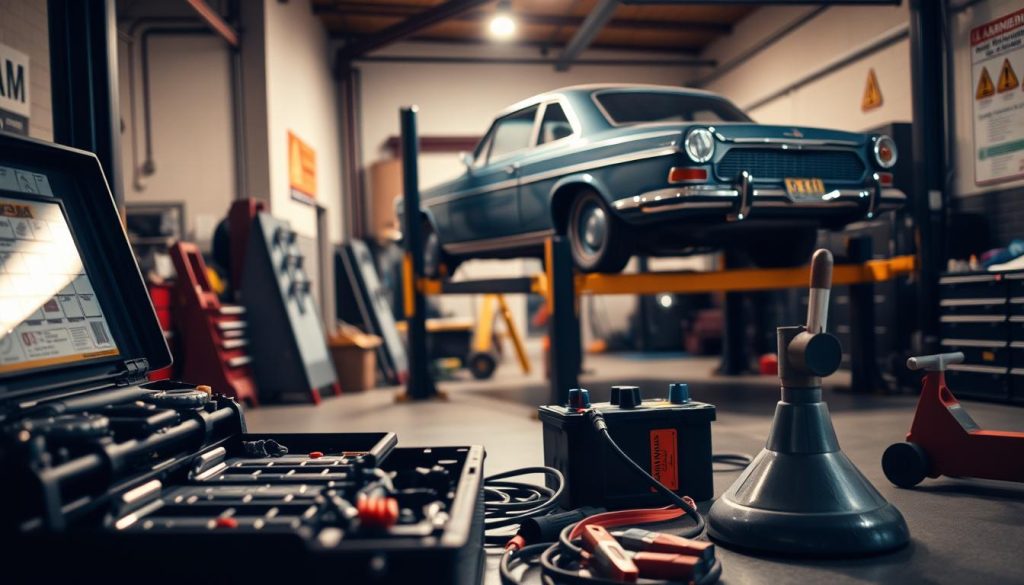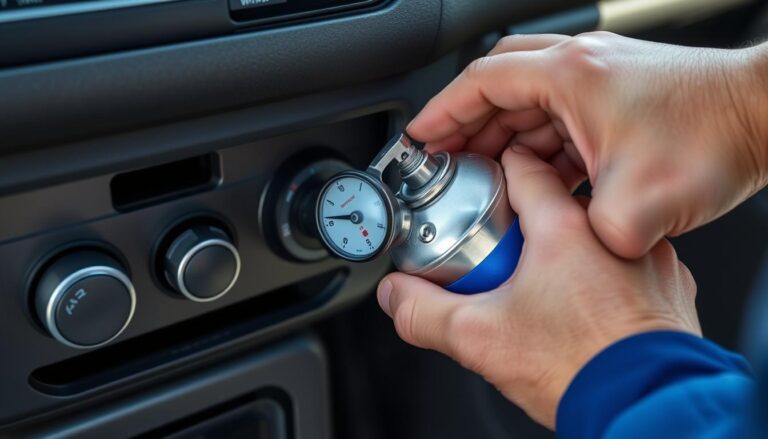The endeavor to jumpstart a dormant car that has lain dormant for years is a complex and daunting task. It necessitates a meticulous approach and a profound comprehension of the requisite steps to circumvent potential hazards.
The revival of a long-idle vehicle confronts one with a plethora of challenges, encompassing both mechanical and safety considerations. Adequate car maintenance is imperative to guarantee the vehicle’s return to operational status without incurring additional damage.
This guide endeavors to offer a detailed, step-by-step methodology for reviving your dormant vehicle. It encompasses critical aspects of automotive repair and maintenance.
Key Takeaways
- Understand the risks and challenges of jumpstarting a dormant car.
- Learn the necessary steps to safely revive a long-idle vehicle.
- Discover essential car maintenance tips to prevent future issues.
- Gain insights into basic automotive repair principles.
- Follow a step-by-step guide to jumpstart your car successfully.
Why Cars Struggle After Long Periods of Inactivity
Extended periods of inactivity can precipitate a myriad of challenges for stationary vehicles, rendering them recalcitrant to restart. This phenomenon is attributed to a confluence of factors that compromise the vehicle’s integrity.
Common Issues with Dormant Vehicles
Dormant vehicles are susceptible to several prevalent issues, including battery degradation, fluid deterioration, and mechanical component seizure.
Battery Degradation and Electrical Problems
The natural process of battery discharge over time precipitates electrical malfunctions, a direct consequence of battery degradation.
Fluid Deterioration and Seals
The degradation of engine oil and coolant fluids impairs the vehicle’s seals and engine health, a critical concern for vehicle maintenance.
Mechanical Component Seizure
Lack of lubrication and prolonged inactivity can cause mechanical components to seize, resulting in significant challenges upon restart.
Understanding the Risks of Improper Reactivation
Improper reactivation of dormant vehicles can exacerbate existing damage, underscoring the imperative for meticulous procedures. Reactivating a vehicle necessitates a meticulous approach to avoid worsening existing malfunctions. Grasping these risks is essential for restoring a vehicle to its operational state.

Essential Safety Precautions Before You Begin
To circumvent accidents and injuries, it is imperative to adopt necessary safety precautions prior to jumpstarting a dormant vehicle. The paramount importance of safeguarding oneself is evident when endeavoring to revive a car that has been in a state of dormancy for an extended period.
Required Tools and Equipment
Acquisition of the appropriate tools and equipment is indispensable for a safe and efficacious jumpstart. This entails:
Basic Tool Checklist
- Jumper cables
- A functional vehicle for jumpstarting
- Owner’s manual
Diagnostic Equipment
Employment of diagnostic equipment, such as a multimeter, facilitates the assessment of the battery’s condition and the identification of potential issues.
Personal Safety Measures
Personal safety must be prioritized. This necessitates the donning of protective gear and the creation of a secure working environment.
Protective Gear
- Safety glasses
- Gloves
Working Environment Safety
It is crucial to ensure the area is well-ventilated and devoid of any flammable materials. Vigilance is required to avoid potential hazards such as loose clothing or long hair that could become entangled in the engine.

Initial Vehicle Assessment
To safely revive a car that hasn’t been started in years, begin with a meticulous inspection. This initial vehicle assessment is crucial for identifying potential issues that could complicate the revival process.
Exterior and Interior Inspection
Start by inspecting the vehicle’s exterior and interior. Check for any visible signs of damage or deterioration.
Checking for Structural Issues
Inspect the vehicle’s body for any signs of rust or structural damage. Rust can weaken the vehicle’s structure, making it unsafe to drive.
Tire Condition Assessment
Check the condition of the tires. Look for signs of cracking, uneven wear, or flat spots. Tires that have been stationary for too long may need to be replaced.
Interior Damage Evaluation
Inside the vehicle, check for signs of water damage, mold, or pest infestation. Ensure all dashboard lights and electronics are functioning properly.
Checking for Wildlife and Pest Damage
Animals often seek shelter in abandoned vehicles. Inspect the engine bay and other areas for signs of wildlife or pest damage.
Engine Bay Inspection
Open the hood and inspect the engine bay. Look for nests, droppings, or other signs of animal habitation. Check that all components are intact and not damaged.
Wiring and Hose Examination
Inspect the wiring and hoses for any signs of damage or deterioration. Rodents can chew through wires, causing significant problems.
| Inspection Area | Potential Issues | Action Required |
|---|---|---|
| Exterior Body | Rust, Dents | Repair or Replace Damaged Parts |
| Tires | Cracking, Uneven Wear | Replace Tires if Necessary |
| Engine Bay | Wildlife Nests, Damaged Wires | Clean Out Debris, Repair Wires |
Preparing the Battery System
Initiating the process of reviving a vehicle that has been dormant necessitates a thorough preparation of the battery system. A battery system in optimal condition is paramount for the successful reactivation of a vehicle that has been inactive for an extended period.
Testing the Old Battery
An exhaustive examination of the battery’s state is imperative. This entails the utilization of a multimeter to gauge the voltage and a load test to evaluate the battery’s capacity to retain a charge.
Using a Multimeter
The multimeter serves as a tool to measure the battery’s voltage. A battery at full charge should exhibit a voltage of approximately 12.6 volts. A significantly lower reading may signify a deeply discharged or malfunctioning battery.
Load Testing Procedures
Load testing entails subjecting the battery to a load to assess its performance under stress. This procedure is instrumental in determining the battery’s capability to initiate the engine.
Cleaning Battery Terminals
Corrosion on the battery terminals can impede the battery’s functionality. The process of cleaning the terminals is straightforward, involving the removal of corrosion and ensuring the establishment of proper connections.
Removing Corrosion Safely
To safely remove corrosion, a paste is created by mixing baking soda with water, and it is applied to the terminals. A brush is then employed to scrub away the corrosion, followed by a rinse with water.
Ensuring Proper Connections
Post-cleaning, it is crucial to verify that the terminals are securely attached to the battery posts. Tightening these connections can aid in preventing future malfunctions.
Charging vs. Replacing the Battery
The decision to charge or replace the battery hinges on its condition. If the battery is aged or damaged, replacement may prove more economical. In other instances, charging the battery may suffice.
How to Start A Car That Hasn’t Been Started In Years
Initiating a vehicle that has remained dormant for an extended period necessitates meticulous preparation and a methodical strategy. This endeavor encompasses several pivotal steps, each designed to facilitate a successful ignition.
Pre-Start Fluid Checks
Antecedent to the commencement of the vehicle, a thorough examination of the various lubricants is imperative. This entails verifying the oil level and condition to ascertain its conformity to the manufacturer’s specifications and its integrity.
Oil Level and Condition
The oil level should be assessed via the dipstick, coupled with an evaluation of its state. Should the oil exhibit a darkened hue or appear excessively soiled, a replacement is advisable prior to engine activation.
Coolant System Inspection
An inspection of the coolant system is requisite to confirm its operational efficacy and absence of leaks. The coolant’s level and quality must also be scrutinized.
Brake and Power Steering Fluid
Concurrently, the brake fluid and power steering fluid levels should be evaluated to ensure they are within the recommended parameters.
Addressing the Fuel System
The fuel system constitutes a critical domain that necessitates attention prior to engine ignition. The potential for degraded gasoline poses a significant challenge.
Dealing with Old Gasoline
In instances where the vehicle has been inoperative for an extended duration, the gasoline may have undergone degradation. A prudent course of action would involve draining the existing fuel and replenishing it with fresh stock.
Fuel Filter Considerations
An examination of the fuel filter for any obstructions or damage is essential. Should any irregularities be detected, its replacement is imperative to guarantee unimpeded fuel circulation.
The Proper Jumpstart Procedure
Upon completion of the pre-start evaluations, the execution of a jumpstart becomes feasible. Adherence to the appropriate protocol is crucial to avert potential damage.
Cable Connection Sequence
The jumper cables must be connected in a specific order: positive to positive, followed by negative to negative, and culminating in negative to a metallic surface on the vehicle.
Safe Charging Techniques
It is imperative to verify the compatibility of the donor vehicle’s battery and the integrity of its charging system.
Initial Cranking Strategy
When initiating the engine’s crank, a gentle and brief application is advisable. Prolonged cranking can precipitate damage.
Addressing Common Problems After Starting
Upon successfully reactivating a dormant vehicle, several critical issues may emerge necessitating immediate resolution. Ensuring the vehicle operates smoothly and safely hinges on addressing these problems promptly.
Engine Hesitation and Stalling
Engine hesitation and stalling frequently manifest post-restart of a long-dormant vehicle. These maladies can stem from a multitude of factors, including carburetor or fuel injection problems.
Carburetor/Fuel Injection Issues
A clogged or dirty carburetor or fuel injector can precipitate engine hesitation. The necessity for cleaning or replacing these components may arise.
Air Intake Problems
Air intake malfunctions, such as a clogged air filter, can also induce stalling. It is imperative to inspect and clean the air intake system.
Smoke or Unusual Noises
Smoke or unusual noises emanating from the engine or other vehicle components signal potential issues. Identifying the source of these anomalies is critical.
Identifying Smoke Colors and Causes
Diverse smoke colors signify disparate problems. For instance, white smoke may indicate coolant leakage, whereas black smoke suggests a rich fuel mixture.
Diagnosing Strange Sounds
Unusual sounds often point to worn-out or loose components. A detailed inspection is required to pinpoint the exact issue.
Brake and Steering Issues
Brake and steering malfunctions can occur after prolonged inactivity. It is essential to reactivate the brake system and inspect the power steering.
Brake System Reactivation
Bleeding the brake system to eliminate airlocks is often necessary. Concurrently, inspecting brake pads and rotors for wear is imperative.
Power Steering Concerns
Checking the power steering fluid level and inspecting for leaks can help resolve steering issues.
| Issue | Potential Cause |
|---|---|
| Engine Hesitation | Carburetor/Fuel Injection Issues, Air Intake Problems |
| Smoke | Coolant Leakage, Rich Fuel Mixture |
| Unusual Noises | Worn-out or Loose Parts |
| Brake Issues | Airlocks in Brake System, Worn-out Brake Pads/Rotors |
| Steering Issues | Low Power Steering Fluid, Leaks |
Post-Start Maintenance Requirements
The initiation of a vehicle’s operation is merely the commencement; the sustenance of its functionality post-start is paramount for its enduring viability. Post-dormancy, various components necessitate scrutiny to guarantee the vehicle’s efficacious and secure operation.
Immediate Service Needs
Upon the commencement of your vehicle’s operation, certain services are imperative to avert potential damage and ensure uninterrupted functionality. These include:
Critical Fluid Changes
Fluids, having sat dormant for extended periods, can become corrosive and lose their efficacy. Engine oil, transmission fluid, and coolant must be replaced to safeguard your vehicle’s engine and ancillary components.
Belt and Hose Inspection
Deterioration of belts and hoses can precipitate severe engine damage. It is imperative to inspect these components for signs of wear, cracks, or leaks to avert exorbitant repair costs in the future.
Recommended Inspection Schedule
Adherence to a regular inspection regimen is crucial for the preservation of your vehicle’s health. This entails:
First 100 Miles Checklist
Post-jumpstart, it is advisable to scrutinize your vehicle within the initial 100 miles for any anomalies. Vigilance for unusual noises, leaks, or performance anomalies is paramount.
Long-term Monitoring Points
Subsequent to the initial 100 miles, continued surveillance of your vehicle’s state is imperative. Regular assessments of fluid levels, tire pressure, and brake pads can preempt significant malfunctions.
Adherence to these post-start maintenance protocols can significantly prolong your vehicle’s lifespan and ensure its continued operational integrity.
Conclusion
The process of reviving a car that has lain dormant for years necessitates a meticulous and comprehensive strategy. Adherence to the methodologies detailed within this guide is imperative for successfully reactivating your vehicle and restoring its mobility.
Initial steps are paramount, encompassing a thorough examination of the vehicle’s exterior and interior, coupled with the detection of any potential wildlife or pest infestations. Concurrently, the battery system must be meticulously prepared to facilitate a seamless reactivation.
Post-jumpstart, addressing common maladies such as engine hesitation and stalling, as well as smoke or unusual noises, becomes a priority. Equally critical are the identification and rectification of brake and steering anomalies. The maintenance regimen outlined in this guide is indispensable for preserving the vehicle’s integrity and functionality.
Adherence to the car maintenance tips articulated in this guide is crucial for maintaining your vehicle’s optimal performance. Regular inspections and servicing are instrumental in averting future malfunctions and ensuring the continued smooth operation of your car.
FAQ
What are the common issues with cars that have been inactive for years?
Vehicles inactive for years often suffer from battery degradation, electrical malfunctions, fluid degradation, and mechanical component seizure.
How do I test the old battery before attempting to start the car?
Employ a multimeter to gauge voltage and conduct load tests to evaluate the battery’s state.
What safety precautions should I take before starting a dormant car?
Prior to starting a dormant vehicle, don protective gear, ensure a secure environment, and utilize diagnostic tools to assess the vehicle’s status.
How do I address old gasoline in the fuel system?
To mitigate the effects of aged gasoline, drain the existing fuel and apply a fuel system cleaner to eliminate varnish and debris.
What are the signs of engine hesitation and stalling after starting the car?
Engine hesitation and stalling may stem from carburetor or fuel injection malfunctions, air intake issues, or faulty ignition systems.
How do I reactivate the brake system after starting the car?
Reactivate the brake system by bleeding it to remove air, and inspect for leaks or damaged components.
What maintenance is required after starting a car that has been inactive for years?
Post-reactivation, perform critical fluid changes, inspect belts and hoses, and adhere to a recommended inspection schedule to maintain vehicle functionality.
How often should I check the vehicle’s fluids after starting the car?
Fluid checks should be performed regularly, ideally after each drive, to verify levels and condition.
Can I jumpstart a car that has been inactive for years using a standard jump starter?
Utilizing a high-quality jump starter or a battery charger designed for deep cycle batteries is advisable to prevent electrical system damage.
What are the risks of improperly reactivating a dormant vehicle?
Inadequate reactivation poses significant risks, including damage to electrical, mechanical, and engine components, potentially leading to expensive repairs or rendering the vehicle inoperable.


